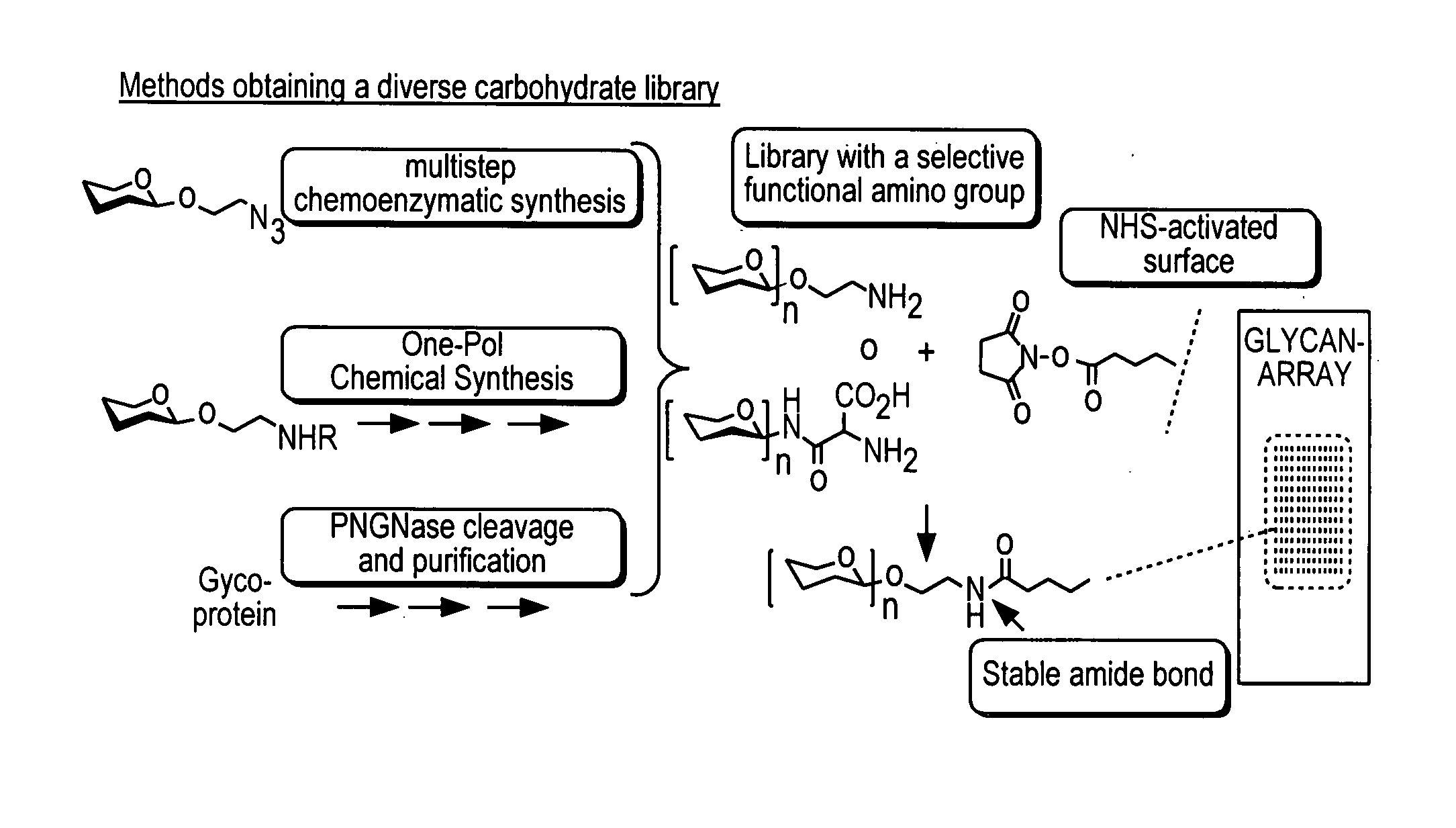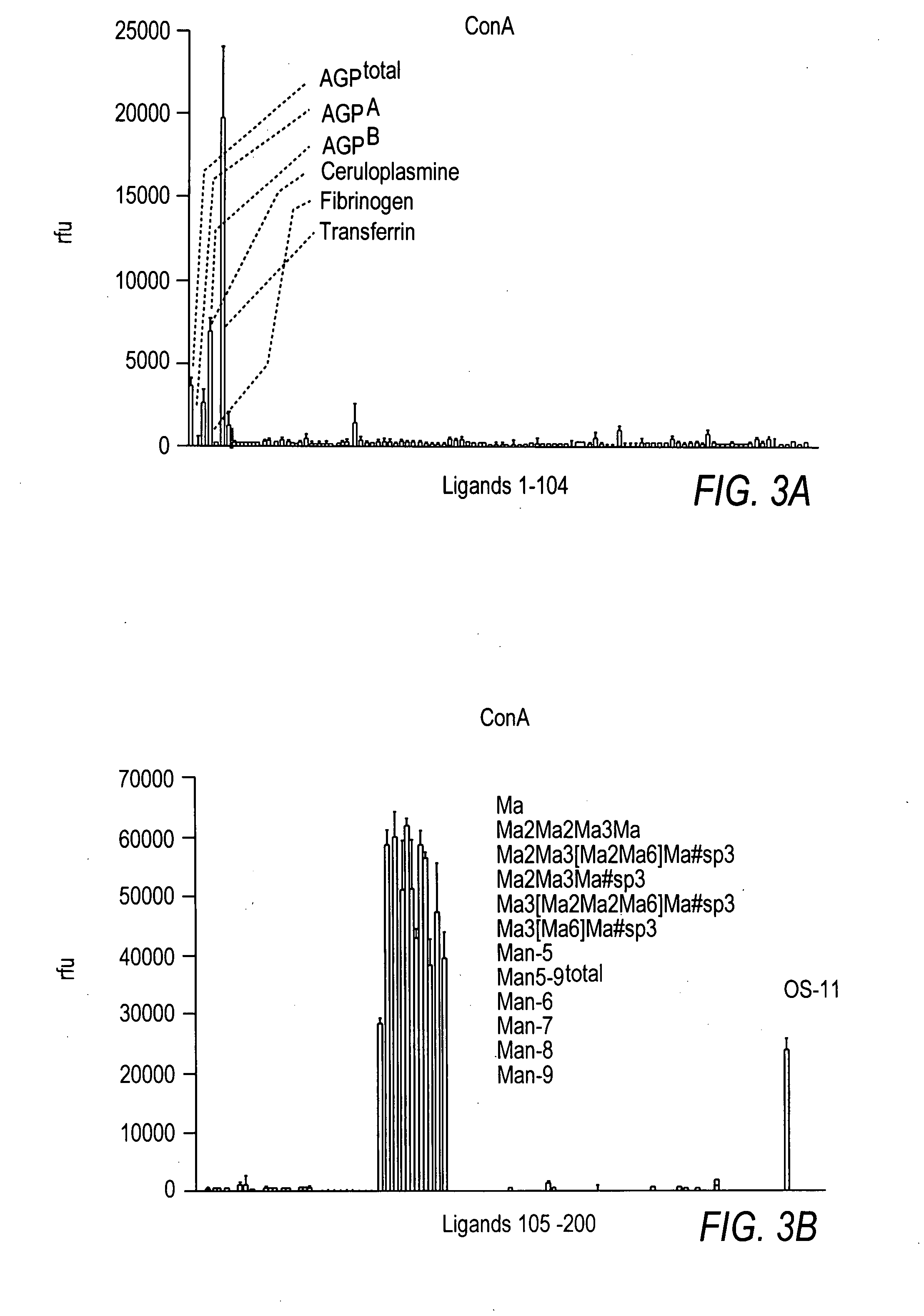Arrays with cleavable linkers
a technology of cleavage linkers and arrays, applied in the field of cleavage linkers, can solve the problems of entanglement between lack of well-defined glycan libraries and analytical methods, and development of glycomics, and achieve the effect of treating or preventing hiv infection
- Summary
- Abstract
- Description
- Claims
- Application Information
AI Technical Summary
Benefits of technology
Problems solved by technology
Method used
Image
Examples
example 1
Enzymatic Synthesis of Glycans
[0179] The inventors have previously cloned and characterized the bacterial N. meningitidis enzymes β4GalT-GalE and β3GlcNAcT. Blixt, O.; Brown, J.; Schur, M.; Wakarchuk, W. and Paulson, J. C., J. Org. Chem. 2001, 66, 2442-2448; Blixt, O.; van Die, I.; Norberg, T. and van den Eijnden, D. H., Glycobiol. 1999, 9, 1061-1071. β4GalT-GalE is a fusion protein constructed from β4GalT and the uridine-5′-diphospho-galactose-4′-epimerase (GalE) for in situ conversion of inexpensive UDP-glucose to UDP-galactose providing a cost efficient strategy.
[0180] Both enzymes, β4GalT-GalE and β3GlcNAcT, were over expressed in E. coli AD202 in a large-scale fermentor (100 L). Bacteria were cultured in 2YT medium and induced with iso-propyl-thiogalactopyranoside (IPTG) to ultimately produce 8-10 g of bacterial cell paste / L cell media. The enzymes were then released from the cells by a microfluidizer and were solubilized in Tris buffer (25 mM, pH 7.5) containing manganese ch...
example 2
Synthesis of Sialic-Acid-Containing Oligosaccharides
[0188] Sialic acid is a generic designation used for 2-keto-3-deoxy-nonulosonic acids. The most commonly occurring derivatives of this series of monosaccharides are those derived from N-acetylneuraminic acid (Neu5Ac), N-glycolylneuraminic acid (Neu5Gc) and the non-aminated 3-deoxy-D-glycero-D-galacto-2-nonulosonic acid (KDN). Sialic-acid-containing oligosaccharides are an important category of carbohydrates that are involved in different biological regulations and functions. Sialic acids are shown to be involved in adsorption of toxins / viruses, and diverse cellular communications through interactions with carbohydrate binding proteins (CBPs). Selectins and Siglecs (sialic acid-binding immunoglobulin-superfamily lectins) are among those well-characterized CBPs that function biologically through sialic acid interactions.
[0189] Synthesis of oligosaccharides containing sialic acids is not trivial. Unfortunately, the chemical approach...
example 3
Synthesis of Ganglioside Mimics
[0197] Gangliosides are glycolipids that comprise a structurally diverse set of sialylated molecules. They are attached and enriched in nervous tissues and they have been found to act as receptors for growth factors, toxins and viruses and to facilitate the attachment of human melanoma and neuroblastoma cells. Kiso, M., Nippon Nogei Kagaku Kaishi. 2002, 76, 1158-1167; Gagnon, M. and Saragovi, H. U., Expert Opinion on Therapeutic Patents. 2002, 12, 1215-1223; Svennerholm, L., Adv. Gen. 2001, 44, 33-41; Schnaar, R. L., Carbohydr. Chem. Biol. 2000, 4, 1013-1027; Ravindranath, M. H.; Gonzales, A. M.; Nishimoto, K.; Tam, W.-Y.; Soh, D. and Morton, D. L., Ind. J. Exp. Biol. 2000, 38, 301-312; Rampersaud, A. A.; Oblinger, J. L.; Ponnappan, R. K.; Burry, R. W. and Yates, A. J., Biochem. Soc. Trans. 1999, 27, 415-422; Nohara, K., Seikagaku. 1999, 71, 337-341.
[0198] Despite the importance of these sialylated ganglioside structures, methods for their efficient ...
PUM
| Property | Measurement | Unit |
|---|---|---|
| Fraction | aaaaa | aaaaa |
| Fraction | aaaaa | aaaaa |
| Fraction | aaaaa | aaaaa |
Abstract
Description
Claims
Application Information
 Login to View More
Login to View More - R&D
- Intellectual Property
- Life Sciences
- Materials
- Tech Scout
- Unparalleled Data Quality
- Higher Quality Content
- 60% Fewer Hallucinations
Browse by: Latest US Patents, China's latest patents, Technical Efficacy Thesaurus, Application Domain, Technology Topic, Popular Technical Reports.
© 2025 PatSnap. All rights reserved.Legal|Privacy policy|Modern Slavery Act Transparency Statement|Sitemap|About US| Contact US: help@patsnap.com



